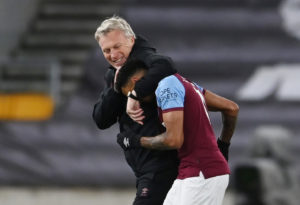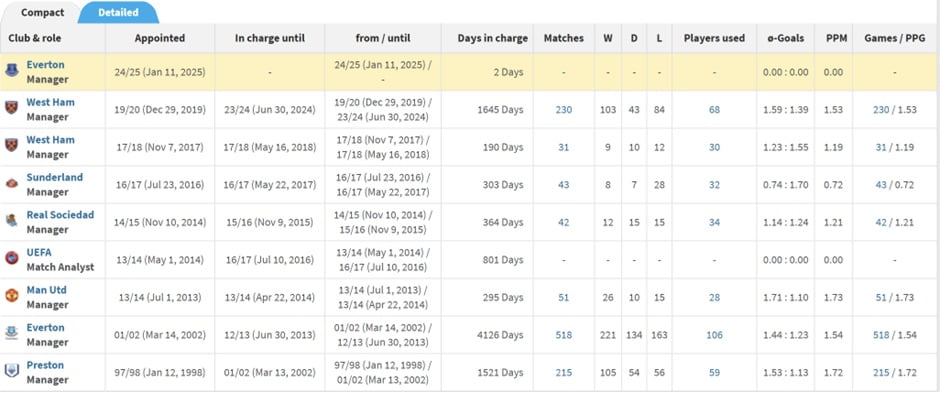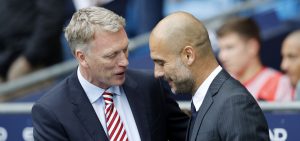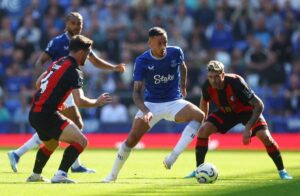David Moyes was appointed manager of Everton for the second time at the weekend, signing a two-and-a-half-year deal with the club he managed between 2002 and 2013.
He returns to Goodison Park having taken a break from the game after a second stint at West Ham United, where, despite winning the club’s first major trophy in 23 years, he was deemed surplus to requirements in favour of a more progressive coach.
“It’s great to be back! I enjoyed 11 wonderful and successful years at Everton and didn’t hesitate when I was offered the opportunity to rejoin this great club. I’m excited to be working with The Friedkin Group and I am looking forward to helping them rebuild the club.
“Now we need Goodison and all Evertonians to play their part in getting behind the players in this important season so we can move into our fabulous new stadium as a Premier League team.” – David Moyes
Everton fans hope he can bring back the good times, while Fantasy Premier League (FPL) managers will be monitoring developments closely.
In our latest Scout Report, we run the rule over Moyes and what it means for the Toffees’ FPL assets.
THE HISTORY

Moyes’ itinerant playing career began in his native Glasgow at Celtic, with whom he won a league title. Then there were spells at Cambridge United, Bristol City, Shrewsbury Town, Dunfermline, Hamilton Academicals and Preston North End.
He became interested in coaching long before retiring, collecting notes on training sessions and tactics and taking his badges. After becoming assistant manager at Preston, he was offered their top job 27 years ago this month. He led them to the 1999/2000 Division Two title and the Division One play-off final in consecutive seasons.
This caught the eye of Everton and the Scot replaced Walter Smith as manager in March 2002. A narrow relegation avoidance in 2003/04 preceded a fourth-place finish in 2004/05 – their highest finish since 1988. Yet one of his biggest disappointments occurred the following August when Everton lost in the Champions League play-offs to eventual semi-finalists Villarreal.
Still, they became an established top-seven club, equalling or bettering that fourth-place points tally on four occasions. They twice finished fifth, alongside a couple in sixth and one in seventh. Furthermore, they reached the 2009 FA Cup final but lost to Chelsea despite taking the lead after 25 seconds.
After departing, Moyes was taken to dinner by Sir Alex Ferguson and offered the poisoned chalice of replacing the most successful manager of all time. He was told Cesc Fabregas, Cristiano Ronaldo and Gareth Bale would be coming to Manchester United but when he got there the only new arrival was Marouane Fellaini.
Moyes lasted only 10 months, as a tired, ageing and demotivated squad – champions during the previous season – limped into seventh.
In an attempt to bounce back, he tried his luck in Spain with Real Sociedad, whom he lifted from 15th place to 12th but the spell lasted only 12 months. Worse was to follow at Sunderland, leading them to their first relegation in 10 years.
Next up for Moyes was West Ham, answering a call to steer them away from the drop. Given a six-month contract, he successfully did so with two matches to spare.

Stats courtesy of Transfermarkt
But nothing else came in for 18 months until being asked back in December 2019 for a similar rescue mission. The club were in 17th place and he kept the Hammers up by the skin of their teeth. Then, the team were transformed, racking up their best-ever Premier League points tally (65), coming sixth and securing Europa League qualification.
In 2021/22, West Ham reached the Europa League semi-finals – eventually losing to Eintracht Frankfurt – and secured back-to-back top-seven finishes in the Premier League for the first time in their history.
Now on a roll, Moyes’ side went on to lift the UEFA Europa Conference League in 2022/23, going the entire continental campaign undefeated and triumphing against Fiorentina in the final. It was the club’s first silverware since 1980.
The fans were elated but, after coming ninth the following season, Moyes left amid rumblings about negative football.
MOYES’ MANAGEMENT STYLE

The 61-year-old is perhaps best described as a pragmatist. The lack of exciting football tends to be a bone of contention with supporters and he’s never really declared a specific philosophy. However, Moyes adapts his approach according to the players at his disposal, often on a shoestring budget and usually with successful results.
With the media, he is sometimes confrontational. The uncompromising Glaswegian makes no bones about letting his players know who is in charge and likes total control. This can extend to player recruitment, an area where he has always wanted to have a say.
He likes scouting players personally and has previously insisted on watching a player up to ten times before deciding whether or not to buy him. Such a method occasionally leads to him missing out on intended targets. At West Ham, he fell out with sporting director Tim Steidten, to the point where he banned the German from the club’s training ground.
Whether he will be afforded such omnipotence under the new owners, the Friedkin Group, remains to be seen. Kevin Thelwell, Everton’s under-pressure sporting director, is unlikely to appreciate such interference and January’s budget will be minimal. Last season, the Toffees were docked points for breaching FFP and later splashed £30m on the underwhelming Beto (£4.9m) during a disappointing summer window.
Despite his abrasive public persona, Moyes is able to motivate his players. In his first stint at Everton, he managed to turn them from relegation candidates into top-four contenders. Their training ground was completely revamped, adding pictures of previous winners and inspirational messages of positivity. Although this practice is commonplace nowadays, it was innovative at the time.
Not only that, Moyes is capable of inspiring strong cup performances, as shown by Everton’s 2009 FA Cup run and West Ham’s joyous European adventures. But, first and foremost, Moyes has been hired to steady the ship – and he has previous on that score.
“The football club’s been in a situation where it definitely wants some stability, and that’s been the message from the owners when they’ve come in. I don’t think it’s going to be off the bat, boat loads of money and crazy things happening.
“People would gladly take that at the minute. The club’s been through a lot lately, whether it’s managerial changes or various other things that have happened, so that, and progress, and let’s see where that takes us.” – Leighton Baines
Except for his disastrous season at Sunderland and stint at Man United – arguably doomed to failure from the start, given his ageing squad and lack of backing in the transfer market – Moyes has generally always managed to improve what he’s been given.
This dedicated leader with a strong work ethic is always first at the training ground and last to leave. A similar commitment is expected from his players. When he first spoke to his West Ham squad, the message was clear.
“Organisation is the key to everything. It’s work ethic. Especially when you’re down in the relegation zone. You can have the best players in the world, but if you don’t work hard, you won’t win games. He has emphasised that if you don’t run, you won’t play, and the lads have took to it. It’s improving us.” – Aaron Cresswell
This approach does not necessarily go down well with all dressing rooms – especially star-studded ones. You can only imagine what Man United’s title-winning players made of Moyes, who had won nothing, ordering them to do doggies for hours on end in the wake of Sir Alex’s departure.
Everton, though, are not title winners. Hearing a voice that doesn’t have them reaching for a packet of Strepsils might be what’s needed
PLAYING STYLE
His sides adopt a solid structure based on a strong defence and midfield runners capable of hitting teams on the break. We saw this with Jarrod Bowen (£7.4m) and, further in the past, Steven Pienaar.
At Everton, his teams were known for being robust and tough to break down. Four at the back and four in midfield, plus Fellaini or Tim Cahill pushing on to support the forward. Out of possession, that floater would retreat and give Everton five in midfield.
A typical midfielder back then was a tough tackler who could also play a bit – Mikel Arteta or Thomas Gravesen. He also used raiding full-backs like Seamus Coleman (£4.3m) and Leighton Baines to aim crosses, corners and free-kicks towards the target man.
Moyes is content at letting opponents dominate possession while his lot hold a tight defensive shape and transition at pace. This can be via a midfield runner or long ball – a strategy that was employed at West Ham with Michail Antonio (£5.3m) required to do the hard-running hold-up play.
“That’s one thing with our gaffer, literally, he loses his mind [over keeping it tight]. When we concede one he’s like ‘you do not concede two within ten minutes’. You’ve got to make sure you work from your shape and then you go for it.
“The only time you can actually really go for it? Last ten of a match you can probably go for it and try and get something if it’s 1-0. But before that, if it’s one goal, you can get that one goal from anything, it could be like a corner, a throw-in, they could score an own goal, anything can happen when it’s 1-0. Just try not to concede two.” – Michail Antonio
4-4-1-1 and 4-2-3-1 formations were generally favoured while at West Ham but he has sometimes experimented with 5-4-1. This would require the left back tucking into a back three but also providing the width in attack. If Moyes decides to coax more goal-scoring chances out of his side, this may be the way to go.
EVERTON FPL PROSPECTS

Everton fans shouldn’t expect any sort of attacking revolution at Goodison Park. Those who remember his first spell in charge won’t be. Moyes has been brought in as a steady hand to ensure Everton don’t get relegated before moving to their new stadium and history tells us he likes a compact defensive set-up.
This is good news for owners or prospective owners of their backline. So far, the Toffees have conceded the seventh-fewest goals (25) and kept the third-most clean sheets (seven).
Therefore Jordan Pickford (£4.9m) remains an appealing goalkeeper. He’s already the second-highest scorer in this position and there’s no reason to assume this defence will start wobbling or suddenly be instructed to start playing out from the back. Moyes won’t want to touch what doesn’t need fixing.
The same applies to the back four. James Tarkowski (£4.8m) and Jarrod Branthwaite (£4.8m) won’t do anything different that detracts from their strengths. Although he might ask his full-backs to offer more in attack. That could be good for Vitalii Mikolenko (£4.3m), Ashley Young (£4.7m) and the recently returned Nathan Patterson (£4.4m). All are capable of delivering good crosses, so could this breathe new life into Dominic Calvert-Lewin (£5.4m)?
Additionally, set-piece threat was a hallmark of his Everton and West Ham sides. This season, the Toffees have managed 34 attempts from corners, the league’s fifth-worst. They’ve scored just twice from such scenarios, which only betters Southampton’s zero.
The key to improving this will be getting the ball up the pitch to actually win such corners. This was a major failing under Sean Dyche. Having Dwight McNeil (£5.1m) absent for a large stretch of the campaign has significantly blunted their attacking threat. He proved a superb early-season budget midfielder but a knee injury has sidelined him since Gameweek 14.
McNeil is the attacking midfielder who could play the Cahill or Fellaini role – supporting the striker with direct running while also being able to deliver a mean corner or free-kick. He can’t return fast enough.
Meanwhile, centre-forwards have been a disaster for them. Again, it’s only Southampton scoring fewer goals (15) and they’re fourth-worst for creating chances (158). Moyes will identify this as their biggest issue to address.
In the absence of McNeil, though, will the cautious Scot be prepared to advance his full-backs and risk losing defensive solidity to produce more goals? We’ll have to wait and see.

Everton’s next two fixtures are against an attack-minded Aston Villa and Tottenham Hotspur. It’ll be interesting to see whether Moyes aims for the draw or finds a way to exploit spaces in behind.
At least we now know they’ll have a Double Gameweek 24, announced on Monday.
VOTE FOR SCOUT AT THE 2025 SPORTS PODCAST AWARDS!

We’re delighted to have been shortlisted for the 2025 Sports Podcast Awards!
We’re a finalist in the Best Fantasy, Betting and Gaming Podcast category – and you can help us win by voting here.
The polls close on January 10.
Thank you for your support!

